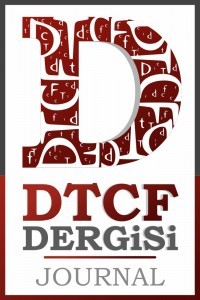THE PINTERESQUE ELEMENTS IN KAZUO ISHIGURO'S “A FAMILY SUPPER”
Pinteresque;, Harold Pinter, Kazuo Ishiguro “A Family Supper”,
___
- Bal, Mustafa. “Memory Plays: Harold Pinter’s Old Times and Anthony Neilson’s Penetrator.” Pamukkale University Journal of Social Sciences Institute 42 (2021): 155-167.
- Dukore, Bernard F. Macmillan Modern Dramatists Harold Pinter. Houndmills: Macmillan Education: 1988.
- Esslin, Martin. The Theatre of the Absurd. New York: Vintage Books, 2001.
- Hollis, James R. Harold Pinter The Poetics of Silence. Illinous: Southern Illinous UP, 1970.
- Ishiguro, Kazuo. “A Family Supper” Discovering Fiction. Eds. Hans P. Guth and Gabriele L. Rica. Boston: Blair Press, 1993. 453-459.
- Ishiguro, Kazuo. “An Interview with Kazuo Ishiguro” Mississippi Review. By Allan Vorda and Kim Herzinger. 20.1-2 (1991): 131-154.
- Jensen, Vernon. “Communicative Functions of Silence.” ETC: A Review of General Semantics 30.3 (1973): 249-257. Web. 17 January 2021.
- Pinter, Harold. “Writing for the Theatre” The New British Drama. Ed. Henry Popkin. New York: 1964.
- Pinter, Harold. “Nobel Lecture Art, Truth & Politics” The Nobel Prize. Web. 9 May 2021.
- “Pinteresque.” Online Oxford English Dictionary. Oxford English Dictionary Online, 2021. Web. 16 January 2021.
- Raby, Peter. “Introduction.” The Cambridge Companion to Harold Pinter. Ed. Peter Raby. New York: Cambridge U P, 2009. 2.
- Rayner, Alice. “Harold Pinter: Narrative and Presence.” Theatre Journal. 40.4 (1988): 482-497.
- Schaffer, Brian W. “‘Somewhere Just Beneath the Surface of Things’: Kazuo Ishiguro’s Short Fiction.” Kazuo Ishiguro. Eds. Sean Matthews and Sebastian Groes. New York: Continuum, 2009. 9-19.
- Walkowitz, Rebecca L. “Ishiguro’s Floating Worlds” ELH 68.4 (2001): 1049-1076. Web. 15 December 2015.
- Zarhy-Levo, Yael. The Making of Theatrical Reputations. Iowa City: U of Iowa P, 2008.
- Yayın Aralığı: Yılda 2 Sayı
- Başlangıç: 1942
- Yayıncı: Ankara Üniversitesi
PSYCHOLOGICAL PLANE: SIGMUND FREUD’S SUBCONSCIOUS MIND IN SIMON STEPHENS’S “BLUEBIRD”
ROBOTLARIN YÜKSELİŞİ: IAN MCEWAN'IN “BENİM GİBİ MAKİNELER” ROMANINDA ETİK SORUNLARIN İNCELENMESİ
ALASDAIR GRAY'İN “THE FALL OF KELVIN WALKER” ADLI ROMANINDA MEKÂN TEMSİLLERİ
TÜRKİYE'DE RÜZGÂR HIZI VERİLERİNİN HOMOJENLEŞTİRİLMESİ VE EĞİLİMLERİ
GARCÍA LORCA'NIN “DOÑA ROSİTA LA SOLTERA”SINDA KADERİN KIZLARI MOİRA'LARIN YANSIMASI
THE PARADOX OF FREE WOMEN IN DORIS LESSING'S “THE GOLDEN NOTEBOOK”
